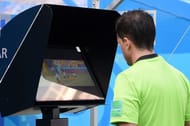We have reached the knockout stage of this year’s world cup and many articles are being written on the most impactful player of the tournament. Names like Ronaldo, Modric, Coutinho, De Bruyne, Neymar, Iniesta, etc are doing the rounds. While Harry Kane, Lukaku and Ronaldo are the top three scorers of the group stage, based on ratings done by some sites, Milan Badelj of Croatia is on the top of the ratings. Further, Sergio Ramos with 95% tops on the most accurate passes given per game and Leo Messi is having the most successful dribbles per game of 74% with average 6.7 dribbles per game. Egypt's El Hadary has the most saves per game of 6 per match whereas Badelj of Croatia is having the most number of intercepts per game with an average of 6 per match.
Debates on social media are getting stronger and stronger surrounding the impacts caused by these players. However, we will be surprised to find out that by sheer numbers and statistics, VAR has caused the most impact on this world cup so far!
The Video Assistant Referee (VAR) system has been introduced by FIFA for the first time in a major tournament. The design principle behind using VAR is to correct “clear mistakes” made by the referee or linesman during the game. As per the FIFA guidelines, VAR can be used only for four specific types of decision: penalties, goals, red cards and cases of mistaken identity. However, the final call will be taken by the referee.
Impact of VAR

Let’s come to the direct impact of VAR in this world cup. There has been a total of 25 penalty kicks in this world cup up to the match between Iran and Portugal held on 25th Jun. That match was the 35th match of this world cup, which will have 64 matches in total. Already this world cup has broken the record of maximum number of penalties, which was previously 18 in 1990, 1998 and 2002 world cups.
Out of the 24 penalties awarded so far, 7 has been awarded by the VAR system; which is a whopping 29% impact. The success rates of the penalties have been 60% with 15 of the total 25 converted into goals. Out of a total of 335 incidents checked through VAR (with an astonishing number of 6.9 average per match), there were 14 decisions changed after VAR reviews. Apart from this, there are so many additional incidents of VAR reviews surrounding red / yellow cards, etc.
While VAR is having its own share of controversy with diversified opinions, it is clear that you may like or hate VAR, but you cannot simply ignore it!
Controversies surrounding VAR

While the introduction of technology like VAR should be welcome, the concern lies on the way it is being implemented. The main bone of contention is the consistency of the decision making. We should not have scenarios when one referee gives a penalty using VAR, whereas another referee does not give a penalty in another match for an exactly similar incident. This has been evident in various matches which could have ended in a different impact.
Some examples of VAR inconsistencies are highlighted below:
- England Vs Tunisia: Harry Kane should have got at least one penalty despite being pulled down during the corner kicks?
- Brazil Vs Costa Rica: Marcelo should have been given a red card for an off-the-ball swipe?
- Sweden Vs Germany: Penalty for Sweden denied in the first half?
- Croatia Vs Argentina: Ante Rebic should have been awarded a red card for stamping on the shins of Eduardo Salvio?
- Portugal Vs Iran: Ronaldo should have been shown red card for his offence?
Issues surrounding VAR

The main issues surrounding the controversies of VAR usage are:
- Different interpretations on what defines a “clear mistake”. On many occasions, many football pundits and fans feel that some of the incidents not acknowledged by the referee falls under the category of "clear mistake". But then it is expected that the central team monitoring VAR will ask the referee to review those incidents and take the final decision through VAR. However, in reality, these are not happening. The alternate approach is to have the individual teams decide on when to call VAR or not based on certain quota system
- Inconsistencies on when VAR should be invoked or referred to by the match officials. While the scope of VAR is decided by VAR, there are some grey area in some of the definitions, specially surrounding a red card decision or on a "clear mistake". Many feel that VAR should be invoked surrounding a rough tackle, even if that happens in the middle of the field. Because the impact of a potential red card will be huge when it comes to the outcome of the match.
- Failure to provide direction and clarification to everyone on when VAR is being called and for what purpose VAR is being referred to. While giant screens are displaying when VAR is called upon, the issue with the television spectators is that they often do not know whether VAR has been called upon or not.
- Inconsistency of VAR induced punishments to so-called “big” players vs other players for similar incidents. There has been allegations that VAR has influenced in showing red cards to players committing rough tackles, however deliberate elbowing from "big" stars like Ronaldo, Marcelo are not getting the same treatment. At maximum, they are being shown a yellow card for these red card equivalent fouls.
Way forward

It is high time FIFA irons outs the issues surrounding VAR. Nobody is disputing the outcome of the decisions once VAR is called upon. What is in contention is when VAR is being invoked by the match officials. This is an easy problem to solve, provided there is clear direction from FIFA on how they want to call out to the match referees. These directions also needs to be put into public domain so that transparency is distributed across all stakeholders.
Already there are alternate proposals in the pipeline to give the decision to use VAR to the two teams – probably one VAR decision per half per team. This is based on how cricket uses the third umpire system to help reduce blatant human mistakes.
Irrespective of what FIFA does, it is clear that VAR is here to stay. Therefore, teams must be careful on the impact of VAR on the outcome of the match. As old habits die long, there must be special sessions arranged by the team management to the players, especially to the defenders. Otherwise, the spectre of more VAR induced penalties are likely to come as we move towards the finals of this world cup!
